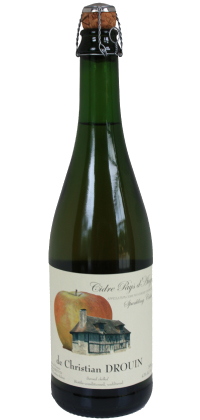Unfiltered & Unpasteurized
Awards:
In the New York Times article "CIDERS OF THE TIMES; A Is for Apple Cider, Sparkling and Intense" in the "Dining Section F6", Cidre Christian Drouin Pays d'Auge & Cidre E. Dupont Bouche Brut were ranked numbers 1 and 2 respectively out of 10 cidres. Cidre Christian Drouin Pays d'Auge received 3 1/2 out of 4 stars while Cidre E. Dupont Bouche Brut recived 3 out of 4 stars.
Production:
The cider is produced in strict compliance with the A.O.C. standard set by the "Institut National des Appellations d'Origine Controlees". The orchard: Currently, apples are still supplied from Gonneville-sur-Honfleur while the orchard at Coeur de Lion matures. It was planted in 1991 and 93 and will be productive between 2005 and 2010. Only low yield varieties are used in order to extract maximum concentration from each apple.
70% of the blend comes from bitter sweet and bitter apples, 20% comes from sweet apples, and 10% comes from acidic apples. Harvesting is carried out by shaking the trees. The fruit is then left in a loft above the press in order to ripen fully. Only mid season and late season apples may be used for the cider. If apples ripening in September were used, they would have to be mashed early in the year when the temperature is to warm for the production of good cider.
Crushing, Pressing and Fermentation: Until 1994, crushing and pressing were combined in one machine. In 1995, the former equipment of the estate was restored: this comprises a crusher, two vats, a hydraulic press, and a receiving tank. After crush, the pomace mascerates for a few hours. This allows the walls of the cells to soften, thereby making it easier to extract juice. The pomace is then conveyed to a hydraulic batch press which extracts the juice by squeezing. The different layers of softened pulp, wrapped in cloth and separated by wooden trays, are mounted on a chariot: each layer is 10 to 12 centimeters high.
The juice is transferred to vats where the fermentation continues for three months. After this time, the cider is bottled and continues to slowly ferment, creating slightly more alcohol and the fine condition.
Pays d'Auge Cidre
Alc./Vol.: 4.5
![]()
